

















Telling the difference between the two is incredibly important, especially in public. Mistakes do happen, but they’re uncommon thanks to the competence of your rectum and anal sphincter. If you think about it, you can nearly always tell what it is. And, by and large, we are confident enough to pass gas without incident. So, how does your butt know?
To get to the bottom of this question, we spoke with Dr. Will Bulsiewicz, U.S. medical director and a board-certified gastroenterologist.
When we asked him how your butt tells the difference between poop and wind, he said: “People don’t think or talk about this enough. And they should! I love this shh… shtuff.” So, let’s get into the details.

To fully appreciate what’s going on, we need to get into some anatomy. Thankfully, Dr. B is well-versed.
Your gastrointestinal tract
Your gastrointestinal (GI) tract is the tube that runs from your mouth to your anus.
When you’re eating and you swallow, the food enters your esophagus, which takes it down to your stomach. After a few hours, the food moves into your small intestine, then eventually into your large intestine. Once the food has passed through the length of the large intestine, digestion is done.
The last two sections of your large intestine are the rectum and anal canal. The rectum is like a storage area for poop. And muscles in its walls help you poop when the time is right.
Below the rectum sits the anal canal, which connects your rectum to your anus ( LMAO ) — the hole through which poop exits your body.
Your anal canal, the final section of your GI tract, will be the main character in this tale. Next, we’ll discuss sphincters.
A sphincter is a ring of muscle that can open and close. You have them throughout your body. For instance, there are sphincters at the top and bottom of your stomach to control when food enters and leaves. The pupil of your eye has a sphincter around it to control how much light enters. And microscopic sphincters help control blood flow in your capillaries.
Two closely related sphincters are involved in pooping. Dr. B explains:
“We have two layers to the sphincter. The external is our squeeze muscle. Like when you decide to squeeze your cheeks to stop a poop from coming out, you are activating the external anal sphincter.” “It’s under voluntary control, so we choose whether it squeezes or relaxes.” “The internal sphincter,” he continues, “is under involuntary control.” “It provides our basal tone, meaning that when we’re not thinking about squeezing our cheeks, our internal sphincter is hard at work maintaining the butt barrier so nothing accidentally sneaks out.”
OK, so we’ve got a little anatomy under our belts. Let’s move on to the next phase.
Men, grab a seat. No – we’re not talking about having a rest on the sofa, we’re talking about sitting ing preferences and it turns out just 24% of men regularly partake in a sit down wee. Well, it turns out on if you choose to stand when you urinate. According to YouGov, men are least likely to sit Professor at UCLA Department of Urology informed us that sitting down to pee could help men tate conditions or men who just can’t stand up for a long time,” When you sit down, you can use feel like you’ve emptied better.” In 2014, researchers from the department of urology at Leiden bladders faster and more effectively. Another pro of a sit down pee is that you don’t have to worry got better aim. So grab a seat the next time nature calls – your bladder and house mates will probably
We all need to pass gas. We also need to poop. You’ve likely noticed that these leave your body via the same exit.
“When the rectum fills beyond a certain capacity,” Dr. B explains, “the rectal walls are stretched, triggering the defecation cycle. This begins with the recto anal inhibitory reflex [RAIR], where the internal sphincter relaxes.”

Now we can partially address the question: How do you know if it’s gas or solid? Take it away, Dr. B: “This RAIR reflex is thought to allow a small amount of rectal contents to descend into the anal canal, where a specialized mucosa samples whether it is gas, liquid, or solid.” According to research, this sampling happens several times every hour. Using that information, Dr. B explains, you can decide whether to “initiate passage of that material.”
Mucosas, or mucous membranes, line the insides of some of your body’s cavities and organs, like your stomach, mouth, and anal canal. They contain glands that produce mucus, hence the name. Two of their primary tasks are making sure surfaces don’t dry out and protecting against pathogens. So, in a nutshell, a specialized mucosa in your anal canal “samples” what’s in your rectum and decides whether it’s safe to release. This brings us closer to answering our initial question. But we still have one more query before the picture is complete: Exactly how does the mucosa differentiate between gas and poop?
Disappointingly, scientists still can’t say exactly how the mucosa differentiates between poop and gas. And there’s been little research into this question, sadly. Still, it seems likely that an unusual abundance of sensory nerve endings in the anal canal play a part. Compared with the rest of your GI tract, your anal canal is incredibly sensitive. Below, we’ll describe some of these nerve endings because this information provides insight into how the final section of your GI tract is so sensitive.
Meissner’s corpuscles: These are incredibly sensitive to fine touch and vibration. They mostly exist on skin without hair that’s sensitive to touch, like your fingertips and the palms of your hand.
Krause end-bulbs (or bulboid corpuscles): Scientists think these are sensitive to cold and might detect pressure and distortion. They’re also common on sensitive, hairless skin and genitals.
Pacinian corpuscles: These are widely distributed in the body, and they respond to pressure and vibration in the anal canal. They’re particularly common in your hands and feet.
Golgi-Mazzoni bodies: These are like smaller versions of Pacinian corpuscles, and they detect changes in tension or pressure. They’re mostly found on your fingertips.
Genital corpuscles: These are similar to the Krause end-bulbs and mostly exist on the penis and clitoris. They likely respond to friction or vibration.
This collection of sensitive detectors helps us understand how our anal canal can differentiate between gas and poop: We would also have no trouble telling the difference if we used our fingers, for instance.
Meanwhile, your anal canal is also sensitive to temperature changes. Some scientists think that detecting the “thermal capacity of rectal contents” might help discriminate between solids and gas.
To recap, once your anal canal has sampled the contents of the rectum and compared all the sensory signals, it decides whether there’s gas or poop in the rectum. This information makes it to your brain.
Then, you can make an informed decision whether to relax your external anal sphincter and release the beast. So, now you know.

Having delved quite deeply into this topic, we have a deeper appreciation for the GI tract’s exit point. We’re also marveling at how your brain can interpret these signals so well, rarely making a messy error.
sitting down the next time you pee. YouGov conducted a study on men’s peeturns out there’s actually a whole host of health benefits you could be missing sit for a wee, with 33% saying they ‘never’ do so. Dr Jesse N. Mills, Associate empty their bladders. “Sitting down is a better option for men with prosyour abdominal muscles more, and you get your last few squirts out and University discovered sitting down to pee allowed men to empty their worry about getting urine on the floor. Mills said: “When you’re sitting you’ve probably thank you for it.
Thanks for joining us on this adventure. We hope you’ll agree that it’s pretty amazing.
Thanks for joining us on this adventure. We hope you’ll agree that it’s pretty amazing.
Millions of dollars’ worth of equipment and cargo goes up in smoke every year because of wheel-end fires, euphemistically called thermal events. You’ll see it on the news or social media, with dramatic footage of thick black smoke and flames consuming an entire trailer — and the tractor, if the driver can’t get the two units unhooked fast enough.
But determining how and where the fires start continues to frustrate the maintenance community, because the damage is often so severe, there’s little left pointing to a cause.
Each fire could be a one-off incident — or it could be indicative of a pattern of events that happens to other fleets too, but fleets likely won’t be aware of what maintenance issues their competitors are experiencing. The American Trucking Associations’ Technology & Maintenance Council surveyed members to determine which, if any, contributing factors might show up as trends across a broad truck and trailer population. Nothing turned up that would give investigators something to focus on. Participation in the survey was light, we’re told, because fleets didn’t want to incriminate themselves by admitting to having had a fire, despite being promised anonymity.
Phil Arnold, a field engineer with Michelin North America, told attendees at TMC’s Fall Meeting that rubber compounds begin to break down when tire temperatures exceed 250 degrees. That’s when a blowout might occur resulting from the deterioration of the tire. It’s not until the rubber reaches temperatures of 500-550 that flammable vapors are emitted by the tire. If an ignition source is present, the rubber will start burning at 650-700 degrees. Spontaneous combustion won’t occur until 850-900 degrees. (The normal operating temperature range for tires is between 100 and 150 degrees).
“Tires contain a great deal of potential energy,” he said. “They are like high-grade coal when they start to burn, and they are very difficult to extinguish.”

When a tire comes apart while driving, it’s usually the result of under inflation. Heat generated within the sidewalls as the tire flexes weakens the steel belts in the casing while softening the rubber to the point it eventually breaks down and the tire blows apart. With tire fires, the heat source is the wheel end. Heat travels through the metal of the hub and through the wheel, where it comes into contact with the tire bead. Since the bead is built differently from the upper sidewall, the rubber there just gets hotter and hotter, until at some point it begins burning, rather than exploding as the casing might due to under inflation.

The source of that heat is friction from either a deteriorating wheel bearing or a dragging brake. In the bearing’s case, failure usually stems from lack of lubrication. There are multiple causes for dragging brakes.
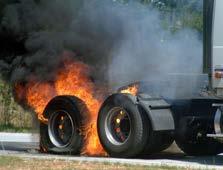
While procedures differ for various wheel-end assemblies and lubricants, at the bare minimum, technicians and drivers should watch for signs of lubricant leakage. Oil-lubricated hubs should be checked every time a trailer enters the shop. The lube should be checked for signs of water contamination (milky appearance), and the oil should be smelled to see if it has been subject to high temperatures (it will smell burnt). Also, the condition of the sight-glass should be checked. With grease-filled hubs where the lubricant is not visible, the wheel should be jacked up, rotated and checked for signs of rough rotation, stiffness or looseness. If the hub cab is removed, verify the correct lube levels (not over-filled), and check for contamination and corrosion on the outer bearing.

Wheel-bearing-related fires can almost always be traced back to lack of lubrication, whether it’s lube loss due to a seal failure or contamination related to water ingress, or debris in the bearing well damaging the seal and causing a leak.
Any situation that might increase friction between the axle spindle and the hub needs to be addressed in the installation and maintenance of the wheel-end assembly.
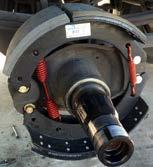
“Over-tightening (excessive preload) the bearing can limit the lube film, which will generate heat, though perhaps not to the level where there’s a risk of a fire,” says Ean Dickerhoof, an application engineer for mobile on-highway products at Timken. “Conversely, excessive end play can affect seal alignment compromising seal life, which can allow debris to enter the system or the lubricant to leak out.”
DRIVERS SHOULD BE TRAINED TO INSPECT HUB CAPS FOR PROPER CONDITION. THIS ONE IS OVER-FILLED WITH LUBRICANT.
Obviously, seal condition and lube levels and condition need to be inspected at regular intervals, Dickerhoof adds, being careful to maintain the proper lube level.
“Some people think packing the cavity full of grease is better than partially filling it,” says Michael Gromosiak, Timken chief application engineer for mobile products. “There’s a certain percentage fill that’s recommended. If you overfill the cavity you can overheat the bearing, because there’s no heat dissipation.”
Timken says bearings ought to run somewhere in the 160-175 degree range. Running at 250 and higher is getting into risky territory. In the case of complete lube depletion, temps will continue to rise until the wheel-end assembly either fails completely and separates from the truck or it heats the surrounding materials to a point where the tire catches fire.
“There are a lot of different reasons a brake can drag to a point of a thermal event occurring,” says Joseph Kay, Meritor director of brake engineering. “In general, it takes a rather large force applied to the brake shoes on a drum brake or brake pads in a disc brake to generate substantial rubbing forces that cause the brake system to get hotter and hotter as the vehicle is driven.”
Kay points to several potential sources, including driving with the parking brake applied, a failed parking chamber diaphragm not compressing the parking spring completely, brakes not releasing after a brake application, corrosion-related binding of the camshaft or disc brake caliper internal parts or sliding system, malfunctioning slack adjusters, or excessive brake lining swell.
“In most cases the driver will not be able to detect one or maybe two brakes that are dragging because of the engine power and weight of the vehicle,” Kay says. “This is where the driver needs to be aware of excessive smoking from the brakes or any handling differences, such as unusual pull or deceleration.”
Literally any moving brake part could be suspect, from valves that do not fully exhaust application pressure due to fouling or corrosion, to broken parking brake springs that inhibit full retraction of the push rod, or lack of S-cam or slack adjuster lubrication, says Keith McComsey, director of marketing and customer solutions – wheel-end at Bendix Spicer Foundation Brake. “Proper preventive maintenance and inspection of all wheel-end components is critical, as is the proper specification and condition of brake linings per the OEM literature.”
As for TMC’s survey results, they revealed 88% of reported fires occurred on vehicles equipped with drum brakes and self-adjusting brake adjusters, while 25% of respondents reported fires on disc-brake-equipped vehicles.
Drivers are the last line of defense against wheel-end fires, but they can’t be expected to notice everything or even know what to look for without proper training in wheel-end inspection.
Drivers should touch and smell the wheel-hub area for excessive temperatures and tell-tale odors of overheated brakes on wheel-ends. On top of that, drivers should “GET OUT AND LOOK” if something doesn’t feel right. A dragging brake can be difficult to detect from the driver’s seat.

Drivers won’t always feel the brake dragging and its not uncommon for a driver to mistake a dragging brake for a heavier-than-usual load, a headwind, or even terrain that seems to make the engine work a little harder.”
Determining the cause of a wheel-end fire might not always be possible, but you can certainly reduce the chances by proper pre-trip procedures and common sense.
Mack
Freightliner: Freightliner:
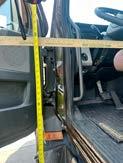



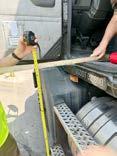


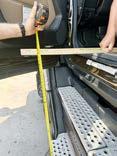
we see what’s really there, or what we’re used to seeing? Are you confused? Understandable. Allow me to explain. not see what we’re looking at. We do it so often, we can see what our brain “wants” to see. We can see a dolly that’s fridge, in vain, for the mustard only to have your spouse point out that “it’s right there in front of your face!” That’s jobs as feeder drivers. They set us (or the next driver) up for success or failure. Ever hook up to a load to find a flat tire sort can depend on catching problems earlier rather than later. And because small problems can grow into catastrophic doing our job with reliable consistency. But, sometimes we need to “snap out of it” and really see what’s in front of our
 ground to 1st step: 17 ” 2nd step: 34 ”
Tractor floor 51 ” seat 70 eat ”
ground to 1st step: 16 ” 2nd step: 35 ”
tractor floor: 50 ” seat: 71 ”
ground to 1st step: 17 ” 2nd step: 34 ”
Tractor floor 51 ” seat 70 eat ”
ground to 1st step: 16 ” 2nd step: 35 ”
tractor floor: 50 ” seat: 71 ”

Congratulations to Ceth Christensen from UPS on winning first place for Step Van and being this years 2023
Congratulations to Ceth Christensen from UPS on winning first place for Step Van and being this years 2023
TDC
Grand Champion!



TDC Grand Champion!
Congratulations to Tim Banasiak from UPS for his first place finish in the 4-axle category at this years Illinois TDC!
Congratulations to Tim Banasiak from UPS for his first place finish in the 4-axle category at this years Illinois TDC!
Congratulations to JIM FISHER from UPS for winning first place in STRAIGHT TRUCK at this years Illinois TDC!
Congratulations to JIM FISHER from UPS for winning first place in STRAIGHT TRUCK at this years Illinois TDC!







Congratulations to Ronald Moore from UPS for winning first place in Sleeper Berth at this years Illinois TDC!
Congratulations to Ronald Moore from UPS for winning first place in Sleeper Berth at this years Illinois TDC!

Congratulations to Edward Mikan from UPS for winning 1st place in Flatbed at this years Illinois TDC!
Congratulations to Edward Mikan from UPS for winning 1st place in Flatbed at this years Illinois TDC!
Congratulations to Team UPS Illinois! Capturing a total of 14 trophies including. 5 first place finishes,Grand Champion, Perfect Pre-Trip, and Team Trophy!


Congratulations to Capturing a total of 14 trophies including. 5 first place finishes,Grand Champion, Perfect Pre-Trip, and Team Trophy!
Independence Day Quote: “Republic. I like the sound of the word. It means people can live free, talk free, go or come, buy or sell, be drunk or sober, however they choose. Some words give you a feeling. Republic is one of those words that makes me tight in the throat - the same tightness a man gets when his baby takes his first step or his first baby shaves and makes his first sound as a man. Some words can give you a feeling that makes your heart warm. Republic __John Wayne.
